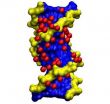(Press-News.org) BLOOMINGTON, Ind. -- Indiana University scientists have found chemical flame retardants in the blood of pet dogs at concentrations five to 10 times higher than in humans, but lower than levels found in a previous study of cats.
Their study, "Flame Retardants in the Serum of Pet Dogs and in their Food," appears this month in the journal Environmental Science & Technology. Authors are Marta Venier, an assistant research scientist in the School of Public and Environmental Affairs, and Ronald Hites, a Distinguished Professor in SPEA.
Venier and Hites explore whether pets could serve as "biosentinels" for monitoring human exposure to compounds present in the households that they share. Dogs may be better proxies than cats, they say, because a dog's metabolism is better equipped to break down the chemicals.
The study focuses on the presence of polybrominated diphenyl ethers (PBDEs) in the blood of dogs and in commercial dog food. PBDEs have been widely used as flame retardants in household furniture and electronics equipment. The compounds can migrate out of the products and enter the environment.
"Even though they've been around for quite awhile, we don't know too much about these compounds' toxicological effects on humans or animals," Venier said. "The bottom line is that we still need to keep measuring them, particularly in homes."
PBDE mixtures made up of less-brominated compounds are regarded as more dangerous because they bioaccumulate in animal tissues. These mixtures were banned by the European Union and were voluntarily removed from the U.S. market in 2004, but remain in the environment. Mixtures with more-brominated compounds remain in use in the U.S. but will be phased out by 2013.
Venier and Hites report on an analysis of flame retardants in blood from 17 pet dogs, all of whom live primarily indoors. They also examined samples of the dry dog food that made up the pets' diet, attempting to determine if food was a major source of PBDE exposure.
The average concentration of PBDEs in blood from the dogs was about 2 nanograms per gram, about five to 10 times higher than the levels found in humans in the few studies of human exposure that have been done in North America.
In dog food samples, the researchers found PBDEs at levels averaging about 1 nanogram per gram. That is much higher than levels found in meat and poultry sold as food for humans, suggesting the PBDEs in dog food may result from processing rather than from the food sources.
A 2007 study by Venier, Hites and several co-authors found concentrations of PBDEs in house cats that were 20 to 100 times higher than levels found in humans. A 2010 article by Venier, Hites and two Clemson University researchers also reported high levels of PBDEs in nesting bald eagles.
Venier said the evidence shows dogs metabolize the compounds more rapidly than cats. A previous study showed that dogs produce an enzyme that breaks down organochlorine pesticides, and a similar mechanism may be at work with brominated compounds.
The current study also detected newer flame retardants that have come onto the market as PBDEs have been removed, including Dechlorane Plus, decabromodiphenylethane, and hexabromocyclododecane. The chemicals are largely unregulated but pose concerns because they are structurally similar to organic pollutants that have been linked to environmental and human health effects.
"The concentrations of these newer flame retardants were relatively low compared to the PBDEs," Venier said, "but the fact that they are new and not regulated suggests their levels are going to increase in the future."
###
The study can be read online at http://pubs.acs.org/doi/full/10.1021/es1043529. To speak with Venier or Hites, please contact Jana Wilson at SPEA, 812-856-5490, wilsonjs@indiana.edu, or Steve Hinnefeld at University Communications, 812-856-3488, slhinnef@indiana.edu.
Study finds flame retardants at high levels in pet dogs
2011-04-26
ELSE PRESS RELEASES FROM THIS DATE:
Total Mortgage Services Launches Cooperative Apartment Lending Program
2011-04-26
Total Mortgage Services, LLC, a leading mortgage lender, announced today it has launched a new lending program for cooperative apartments (co-op) for its retail and wholesale lending channels with some of the most competitive mortgage rates available to qualified borrowers. Currently, Total Mortgage is offering qualified co-op borrowers a 30-year fixed mortgage at rate of 4.875 percent and an APR of 4.995 percent with 0 points.
"We are excited about now being able to offer our competitive mortgage rates and best in class service to co-op borrowers looking to either ...
Blacks more willing to exhaust financial resources for more cancer care
2011-04-26
BIRMINGHAM, Ala. – People in minority groups, especially black Americans, are more willing than their white counterparts to exhaust their personal financial resources to prolong life after being diagnosed with lung or colorectal cancer, according to a University of Alabama at Birmingham study published April 26, 2011, online in Cancer, the journal of the American Cancer Society.
This revelation should inform the treatment plans and help physicians design state-of-the-art cancer care that reflects patient wishes, says lead author Michelle Martin, Ph.D., assistant professor ...
CSHL structural biologists reveal molecular architecture of key NMDA receptor subunit
2011-04-26
Cold Spring Harbor, NY – Structural biologists at Cold Spring Harbor Laboratory (CSHL) in collaboration with colleagues at Emory University have determined the molecular structure of a key portion, or subunit, of a receptor type commonly expressed in brain cells. The receptor is one of several NMDA (N-methyl-D-aspartate) receptor variants, and the subunit in question is that which specifically binds with excitatory neurotransmitters, most notably glutamate, the brain's most prevalent excitatory neurotransmitter.
The discovery is important because knowledge of the receptor ...
Providers Seek Improved Efficiencies and Better Patient Care Through Adaptable Interventional Labs
2011-04-26
Over the last two years KLAS has seen an increase in the interventional lab market performance scores for GE, Siemens, and Toshiba --narrowing the gap with each other and with install base leader, Philips. According to a new KLAS report, "Interventional Labs 2011: Meeting Changing Needs," the four ranked vendors (GE, Philips, Siemens, and Toshiba--listed alphabetically) cluster within five points of each other.
As performance scores tighten, market-changing development from vendors has slowed. Additionally, provider innovation and the move toward multiuse ...
Gynecologic cancer expert helps pinpoint best treatment for fast-growing gestational tumors
2011-04-26
DALLAS – April 26, 2011 – A clinical trial has sifted out the most effective single-drug chemotherapy regimen for quick-growing but highly curable cancers that arise from the placentas of pregnant women.
In the comparison trial for treating low-risk gestational trophoblastic neoplasia (GTN), researchers found that a biweekly dose of dactinomycin had a higher complete response rate than a weekly dose of methotrexate, the more commonly used drug. GTN is a group of rare tumors that involve abnormal growth of cells inside a woman's uterus.
"Both chemotherapy drugs are effective ...
Antibiotic may prove beneficial to preterm infant lung health
2011-04-26
LEXINGTON, Ky. (April 26, 2011) – A study performed by University of Kentucky researchers shows promise for the use of azithromycin in treating Ureaplasma-colonized or infected premature infants to prevent bronchopulmonary dysplasia (BPD).
The study, published in Pediatric Pulmonology, showed subjects colonized or infected with the Ureaplasma bacteria developed BPD or died 73 percent of the time in the azithromycin-treated group, compared to 94 percent of the time in the placebo group.
Bronchopulmonary dysplasia is a chronic lung disorder characterized by inflammation ...
Archie's Island Furniture Says a Big "Happy Summer" With Fun New Products
2011-04-26
Archie's Island Furniture, manufacturer of premium painted outdoor furniture, announces the addition of new products to jumpstart summer, in response to the lengthy and brutal New England winter.
The new outdoor furniture, expanding Archie's outdoor dining and casual entertaining product lines, offers fun configurations and great color choices for both large and small gatherings. New to the collection this year are an intimately scaled 38" round dining table seating four, porch swings in several lengths and designs, and a coffee table, (42"L, 18"W, 18"H), ...
Novel ash analysis validates volcano no-fly zones
2011-04-26
Planes were grounded all over Europe when the Eyjafjallajökull volcano erupted in Iceland last year. But no one knew if the no fly zone was really necessary. And the only way to find out would have been to fly a plane through the ash cloud - a potentially fatal experiment.
Now a team of researchers from the University of Copenhagen and the University of Iceland have developed a protocol for rapidly providing air traffic authorities with the data they need for deciding whether or not to ground planes next time ash threatens airspace safety.
A study by the teams of Professors ...
Protein inhibitor may bring a topical treatment for HPV
2011-04-26
BOSTON (April 26, 2011) —Human papillomavirus (HPV) causes cervical cancer, the second most common cause of cancer death for women, and is a common cause of anogenital and some head and neck cancers. Thanks to research being done at Tufts University School of Medicine, patients infected with cancer-causing HPV may someday have an alternative to surgical and harsh chemical treatments. In a study funded by the National Institutes of Health and published online in advance of print in The FASEB Journal, the researchers report on the development of a protein-based inhibitor ...
Water molecules characterize the structure of DNA genetic material
2011-04-26
Water molecules surround the genetic material DNA in a very specific way. Scientists at the Helmholtz-Zentrum Dresden-Rossendorf (HZDR) have discovered that, on the one hand, the texture of this hydration shell depends on the water content and, on the other hand, actually influences the structure of the genetic substance itself. These findings are not only important in understanding the biological function of DNA; they could also be used for the construction of new DNA-based materials.
The DNA's double helix never occurs in isolation; instead, its entire surface is ...


